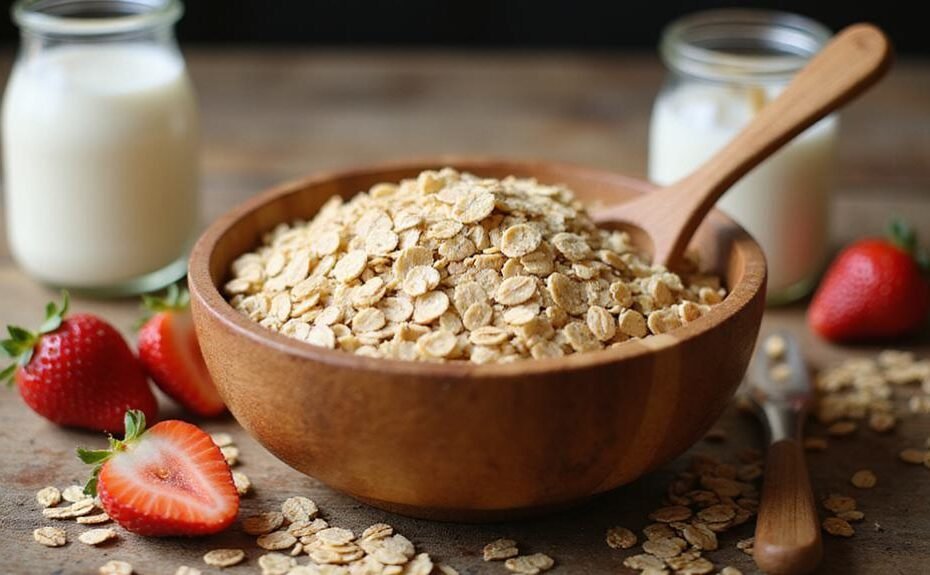Oats: Benefits, Side Effects, Nutrition, Uses and More
Oats are whole grain cereal crops rich in soluble fiber, particularly beta-glucan, that provide substantial nutritional value through protein, complex carbohydrates, and essential minerals like manganese, phosphorus, and magnesium while supporting heart health, blood sugar regulation, and digestive wellness.
The cholesterol-lowering properties of oats, their nutritional composition, potential side effects for certain individuals, proper consumption guidelines, comparison with alternative grains like flaxseed, and evidence-based recommendations for incorporating oats into various dietary patterns is explored in this post, below.
Trumpai
- Oats reduce cholesterol and improve heart health through beta-glucan fiber, with 90g daily recommended for cholesterol reduction.
- One cup of raw oats contains 300-307 calories and provides essential nutrients like manganese, phosphorus, and B vitamins.
- Potential side effects include bloating, gas, and cross-contamination concerns for celiac disease patients.
- Oats help regulate blood sugar, improve insulin sensitivity, and promote digestive health through increased stool bulk.
- Standard serving size is 40g dry oats or 80g cooked oats, with whole grain forms preferred for optimal nutrient absorption.
Potential Benefits
Potential Benefits
Oats may reduce total and LDL cholesterol levels through beta-glucan fiber, which increases bile excretion of cholesterol. They may also decrease small, dense LDL particles and protect against LDL oxidation, potentially lowering heart disease risk.
Oats may provide consistent blood sugar regulation benefits by slowing glucose absorption and potentially improving insulin sensitivity, making them valuable for type 2 diabetes management.
The beta-glucan in oats may increase stool bulk while promoting beneficial gut bacteria growth, supporting digestive health regardless of cooking method.
Additionally, oats may contain unique antioxidants called avenanthramides that may reduce arterial inflammation and enhance immune function through stimulation of natural defense mechanisms.
For optimal health benefits, regular consumption may be beneficial, but individual needs may vary. If you have specific health concerns, please consult with a doctor before making significant dietary changes.
Remember that drinking water is important when consuming foods high in fiber like oats.
Nutritional Information, Calories
Nutritional Information, Calories
Oats provide 300-307 kcal per 81g cup (raw), 379 kcal per 100g (rolled uncooked), or 140 kcal per serving (cooked).
Macronutrient Profile (per serving, varies by form):
- Protein: 10.7-11g
- Carbohydrates: 54.8-67.7g
- Fat: 5.3-6.52g
- Fiber: 8.1-10.1g total (including 4g beta-glucan per 100g)
Key Micronutrients:
- Manganese: 173% DV
- Phosphorus
- Thiamine
- Pantothenic acid
- Other B vitamins
Oats may be found in various foods including:
- Oatmeal
- Granola
- Energy bars
- Baked goods
- Breakfast cereals
The fiber content in oats may help support digestive health and cholesterol management.
The beta-glucan content may be particularly beneficial for heart health.
For optimal nutritional benefits, whole oats may be preferable to highly processed varieties.
Recommended intake may vary by individual, especially for those monitoring caloric intake or specific nutrients.
Please consult with a doctor or your personal trainer about incorporating oats into your diet.
Drinking water is important when consuming high-fiber foods like oats.
Potential Side Effects
Side effects of oat consumption may include gas production, bloating, allergic reactions, blood sugar fluctuations, exposure to chlormequat residues, and potential blockages in pre-existing digestive tract narrowing.
Regular oat consumption may cause gastrointestinal discomfort as the body adapts to the high fiber content. Sensitive individuals may experience allergic responses to avenin proteins found in oats. Overconsumption, particularly of sweetened varieties, may lead to blood sugar fluctuations.
Studies may indicate that 92% of tested oat products contain chlormequat residues which may raise potential health concerns. Individuals with narrowing in their digestive tract may face an increased risk of blockages when consuming oats.
Persons with celiac disease may need to exercise particular caution, as cross-contamination with gluten may occur even in certified gluten-free varieties. Gradually introducing oats into your diet and monitoring your body’s response may help minimize adverse effects while maintaining nutritional benefits.
Drinking water while consuming oat products may help reduce digestive discomfort. If you experience persistent side effects, please consult a doctor before continuing oat consumption.
Use and dosage recomendations
Daily oat dosage may range from 40-80g for general health and 90g for cholesterol reduction.
For general health maintenance, consuming 40-80g of dry oats daily may be recommended, while cholesterol reduction may require approximately 3g of beta-glucan daily, equivalent to about 90g of oats.
Standard serving size measurements may include 40g dry oats or 80g cooked oats (roughly the size of a baseball).
Those managing celiac disease may need 50-70g daily for adults and 20-25g for children.
For ideal nutrient absorption, whole grain forms may be more beneficial than instant varieties, and combining with fruits or nuts may enhance nutritional benefits.
When increasing oat consumption, drinking water is important to prevent gastrointestinal discomfort.
It may be advisable to space oat intake away from medications like lovastatin.
However, dosage may vary by individual, so please consult with a doctor or your personal trainer before making significant changes to your diet.
Oats Vs Flaxseed Comparison
Oats Vs Flaxseed: Nutritional Comparison
Key Differences
- Caloric content: Flaxseeds (534 calories/100g) provide significantly higher energy than oats (389 calories/100g)
- Macronutrient distribution: Oats are carbohydrate-dominant (67%), while flaxseeds are primarily fat-based (66%)
- Mineral content: Flaxseeds contain 372% more calcium than oats (255mg vs 54mg per 100g)
- Vitamin content: Flaxseeds offer nearly double the folate of oats (87µg vs 56µg)
Benefits of Oats
- Provide sustained energy through complex carbohydrates
- Support blood sugar regulation with beta-glucan fiber
- Maintain consistent nutrient profile across different processing methods
- Lower calorie density compared to flaxseeds
Benefits of Flaxseeds
- Rich source of essential omega-3 fatty acids
- Superior calcium content for bone health
- Higher folate levels for cellular function
- Provide anti-inflammatory benefits
Considerations
Both foods complement each other nutritionally, making them valuable additions to a balanced diet for different nutritional purposes.
What diseases or symptoms can this potentially help treat or alleviate?
Oats may help treat heart disease, type 2 diabetes, constipation, digestive issues, and inflammatory conditions.
Oats may target heart disease by lowering total and LDL cholesterol through beta-glucan fiber, which may promote excretion of cholesterol-rich bile. Additionally, avenanthramides in oats may prevent LDL oxidation and improve blood flow by increasing nitric oxide production.
For metabolic health, oats may regulate blood sugar by slowing carbohydrate absorption and improving insulin sensitivity, making them potentially valuable for type 2 diabetes management. Their high fiber content may address digestive issues like constipation while enhancing the gut microbiome.
The anti-inflammatory properties of avenanthramides may alleviate gastrointestinal inflammation and protect against oxidative stress. Oats may also support immune function through beta-glucans that enhance pathogen recognition, while providing essential micronutrients often lacking in restricted diets.
Dosage may vary by individual, so please consult with a doctor before making significant dietary changes. Drinking water is important when increasing fiber intake from oats to prevent digestive discomfort.
Frequently Asked Questions
Can Babies Eat Oats and at What Age?
Babies may eat oats starting around 6 months of age when they show signs of readiness. This nutritious first baby food may be prepared in various oat recipes, potentially supporting digestive health with fiber and essential nutrients like iron, protein, and B vitamins. When introducing oats, parents may want to monitor for any allergic reactions, though oats are generally considered a low-allergen food. The texture of oats may be adjusted from thin (about 150-180 ml of liquid to 15-20 grams of oats) to thicker consistency as baby develops. Always consult with a doctor before introducing new foods into your baby’s diet.
Are Oats Gluten-Free and Safe for Celiac Disease?
Yes, oats are naturally gluten-free, but people with celiac disease should only consume certified gluten-free oats due to cross-contamination risks. Pure oat varieties may be naturally gluten-free, but gluten cross-contamination during processing may make certified gluten-free oats essential for celiac patients. Most people may tolerate them well, though individual sensitivities may occur. Important factors include celiac disease, gluten sensitivity, cross-contamination, and certification standards.
How Do You Grow Oats at Home?
Oats can be grown at home using soil that may drain well with a pH of 6-7.5 and full sun exposure. Different oat varieties should be sown 2.5-3.8 centimeters deep, spaced 7.6-20.3 centimeters apart. For successful growth, maintaining consistent moisture during germination may be important. Appropriate planting techniques include proper soil preparation, adequate spacing, and regular water drinking for the plants. Important factors for home oat cultivation may include soil quality, sunlight exposure, moisture levels, and selecting suitable oat varieties for your climate.
Can Pets Like Dogs and Cats Safely Consume Oats?
Yes, pets like dogs and cats can safely consume oats, though with different benefits for each species. Dogs may safely consume plain, cooked oats as a digestive aid and skin health supplement. Cats, being obligate carnivores, may benefit less from oat recipes. Consulting a doctor guarantees proper pet nutrition balance. Important considerations include serving plain oats without sugar or additives, cooking them thoroughly, and introducing them gradually into your pet’s diet. Portion sizes should be appropriate – small dogs may have 1-2 tablespoons (15-30 milliliters), while larger breeds may consume up to 0.25 cup (about 60 milliliters).
What’s the Environmental Impact of Oat Cultivation?
Oat cultivation may have a positive environmental impact due to its sustainable farming practices. Oat crops may require considerably lower water usage compared to dairy production. Research suggests oats may need minimal irrigation and 70% less land, which may contribute to reduced greenhouse gas emissions in agricultural systems. Important factors related to the environmental impact of oat cultivation include water efficiency, land use, greenhouse gas emissions, and sustainable agricultural methods. Typical oat farms may use approximately 70% less space than dairy operations, equivalent to about 0.3 hectares versus 1 hectare for comparable production.
References
- https://www.healthline.com/nutrition/9-benefits-oats-oatmeal
- https://nutritionsource.hsph.harvard.edu/food-features/oats/
- https://pubmed.ncbi.nlm.nih.gov/34828872/
- https://www.heart.org/en/news/2022/09/01/take-a-fresh-look-at-oatmeal-its-not-as-simple-as-you-think
- https://wholegrainscouncil.org/whole-grains-101/easy-ways-enjoy-whole-grains/grain-month-calendar/oats-–-january-grain-month/health
- https://www.healthline.com/nutrition/foods/oats
- https://www.nutritionvalue.org/Oats
- https://en.wikipedia.org/wiki/Rolled_oats
- https://www.verywellfit.com/oats-nutrition-facts-calories-and-health-benefits-4118577
- https://www.quakeroats.com/products/hot-cereals/old-fashioned-oats

